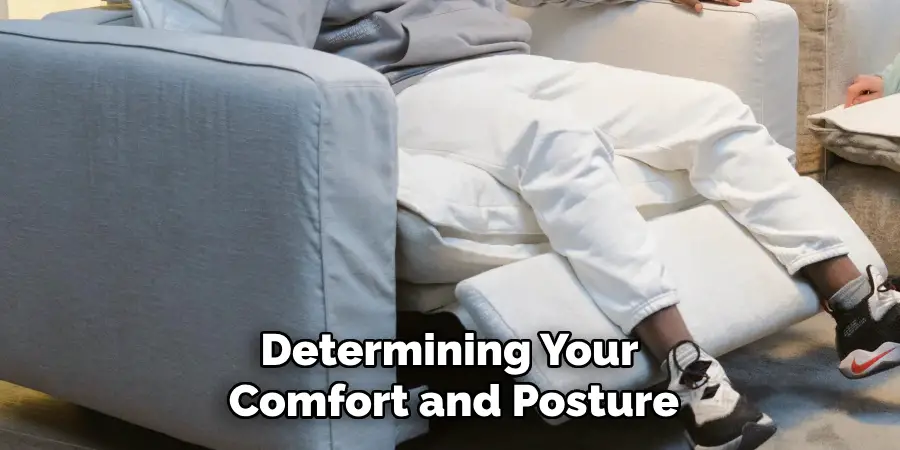Sitting properly on a sofa may seem simple, but it plays a crucial role in maintaining good posture and preventing back or neck pain. A well-supported seated position can enhance comfort and promote better spinal alignment. In this guide, we will explore how to sit properly on a sofa. Whether you’re watching TV, reading a book, or simply relaxing, adopting the right posture can make a significant difference in your overall well-being.

Importance of Proper Posture
Maintaining proper posture while sitting on a sofa is essential for several reasons. Good posture helps to distribute your body weight evenly, reducing the strain on your spine, muscles, and ligaments. This, in turn, can alleviate back and neck pain, which are common issues associated with prolonged sitting. Additionally, proper posture supports efficient breathing and circulation, allowing your body to function optimally. By keeping your spine aligned and your core engaged, you can also prevent long-term musculoskeletal disorders and improve your overall balance and coordination. Adopting the right sitting habits not only enhances comfort but contributes significantly to your long-term health and well-being.
Why Proper Sitting on a Sofa Matters
Proper sitting on a sofa matters for a multitude of health reasons. Incorrect posture can lead to various complications, including chronic back pain, muscle fatigue, and even nerve compression over time. Sofas are often designed for comfort rather than ergonomic support, which can make slouching easy and maintaining good posture challenging.
Consistently sitting with poor posture can exacerbate existing health issues or lead to new ones. Furthermore, proper sitting isn’t just about avoiding pain; it’s about fostering an environment for your body to stay productive and energetic. When your body is well-supported, you reduce unnecessary stress and tension, making relaxation more genuine and rejuvenating. Overall, investing effort into sitting properly can lead to a significant elevation in your daily physical comfort and long-term health.
Health Risks Associated with Wrong Sitting Posture

Adopting an incorrect sitting posture on a sofa can lead to a variety of health issues, some of which can become chronic over time. Slouching or sitting with an imbalanced posture puts undue pressure on the spine, leading to potential back pain and spinal misalignment. This incorrect alignment can also result in muscle strain and tension, particularly in the neck, shoulders, and lower back. Over time, habitual poor posture can contribute to the shortening of muscles and weakening of core strength, which exacerbates musculoskeletal problems.
Moreover, slouching compresses the organs, potentially impairing good digestion and circulation, which can affect your overall energy levels and well-being. In severe cases, nerve compression can occur, leading to symptoms like numbness or tingling in the limbs. Understanding these risks underscores the importance of maintaining a proper sitting posture to safeguard your health.
10 Methods How to Sit Properly on a Sofa
1. Maintain an Upright Posture
Sitting with an upright posture on a sofa is essential for comfort and spinal health. Avoid slouching or sinking deeply into the cushions, as this can strain your back over time. Position your lower back against the sofa’s backrest to maintain the natural curve of your spine. Your shoulders should remain relaxed, not hunched forward, and your head should be aligned with your neck. Using a small lumbar cushion for additional support can help you sustain this posture effortlessly during extended periods.
2. Keep Your Feet Flat on the Floor

For optimal alignment, ensure that your feet rest flat on the floor while sitting on a sofa. This stabilizes your body and prevents undue pressure on your legs and lower back. Adjust your position or choose a sofa with a seat height that allows your knees to bend at a right angle, with your thighs parallel to the ground. If your feet dangle, use a footrest to provide adequate support and maintain proper circulation.
3. Distribute Your Weight Evenly
When sitting on a sofa, distribute your weight evenly across both hips to avoid putting strain on one side of your body. Uneven weight distribution can lead to discomfort and long-term posture issues. Sit squarely in the middle of your chosen spot, keeping your hips aligned with your shoulders. This balance promotes proper alignment and ensures that you can sit comfortably for extended periods without feeling fatigued.
4. Use Cushions for Support
Cushions are not just decorative; they can be functional in enhancing your sitting posture. Place a cushion behind your lower back for lumbar support or under your thighs if the sofa seat is too deep. If you feel tension in your neck or shoulders, use a cushion to elevate your arms slightly by placing it under your elbow. Adjusting the cushions to suit your body’s needs ensures a more customized and comfortable seating experience.
5. Avoid Crossing Your Legs
While crossing your legs might feel natural, it can disrupt circulation and contribute to poor posture. Instead, keep both feet flat on the floor or cross your ankles lightly. If you prefer sitting with your legs tucked under you, switch positions frequently to prevent stiffness and ensure balanced support. Maintaining proper leg alignment while sitting reduces pressure on your hips and promotes better blood flow.
6. Sit Close to the Backrest

Always position yourself close to the backrest of the sofa for maximum support. Sitting too far forward places strain on your lower back and encourages slouching. Slide back until your hips touch the backrest, allowing the sofa to provide full support for your spine. If the sofa’s depth makes it challenging to sit properly, consider adding cushions to reduce the seating depth and make it more ergonomic.
7. Align Your Arms Comfortably
Position your arms in a relaxed and natural posture while sitting on a sofa. If the sofa has armrests, use them to support your elbows without raising your shoulders. For sofas without armrests, rest your hands on your lap or use a cushion for added support. Avoid holding your arms in awkward positions, as this can cause tension in your shoulders and upper back. Keeping your arms relaxed contributes to an overall comfortable sitting experience.
8. Adjust Your Position Regularly
Sitting in one position for extended periods can lead to stiffness and discomfort. Make a habit of shifting your position every 20-30 minutes to improve circulation and relieve pressure points. Stretch your legs, roll your shoulders, or recline slightly to prevent muscle fatigue. Regular adjustments keep your body relaxed and help maintain a healthy posture, especially during prolonged sitting sessions like movie nights or long conversations.
9. Recline in Moderation
Many sofas offer reclining options, but it’s important to use them moderately to maintain proper alignment. When reclining, keep your lower back supported and avoid excessive angles that strain your neck or force your head forward. A slight recline can relieve pressure on your spine, but ensure your head and neck remain aligned with your body. Using a neck pillow or adjustable headrest can enhance the comfort and ergonomics of a reclined position.
10. Choose the Right Sofa for Your Body Type

The sofa you sit on plays a significant role in determining your comfort and posture. Select a sofa with the appropriate seat depth, height, and firmness to suit your body type. For example, individuals with shorter legs might prefer a shallower seat, while taller individuals may need a deeper one. Firm cushions provide better support, while overly soft cushions can encourage slouching. Test sofas before purchasing to ensure they support proper sitting posture and meet your personal comfort preferences.
Things to Consider When Buying a Sofa
When choosing a sofa, there are several essential factors to consider to ensure it meets your needs and supports proper posture:
- Size and Space Availability: Measure the area where you intend to place the sofa to ensure it fits comfortably, without overwhelming the room. Consider the size of the sofa in relation to other furniture and the walking space you will need.
- Material and Durability: Select a fabric or leather that complements your lifestyle. If you have pets or children, durable, easy-to-clean materials such as microfiber or leather might be ideal.
- Seat Height and Depth: Match the sofa’s dimensions to your body type. A seat that’s too deep could make it difficult for shorter individuals to sit comfortably, whereas a seat that’s too shallow might not offer enough support for taller people.
- Cushion Firmness: Consider whether you prefer a firm or soft seating experience. Keep in mind that firmer cushions generally provide better support for spinal alignment.
- Style and Aesthetics: Choose a design that complements the overall decor and ambiance of your living space. Consider colors, patterns, and the style of the sofa—whether modern, classic, or something in between.
- Budget: Determine a budget that balances quality and affordability. Investing in a high-quality sofa can provide better comfort and longevity, but ensure it aligns with your financial plan.
Taking the time to evaluate these factors will help you select a sofa that not only enhances your living space aesthetically but also supports your health and comfort needs.
Conclusion
Incorporating thoughtful ergonomics and considering personal comfort when selecting a sofa can significantly impact your overall well-being. By paying attention to aspects such as posture, cushion support, and material durability, you can enhance both your comfort and your home’s aesthetic appeal. Ensuring proper sitting techniques and making informed choices about your furnishings not only promotes healthier posture but also elevates the relaxing experience of your living space. Thanks for reading, and we hope this has given you some inspiration on how to sit properly on a sofa!

